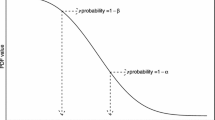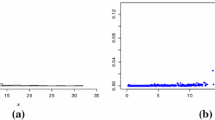Abstract
Assessment of heavy tailed data and its compound sums has many applications in insurance, auditing and operational risk capital assessment among others. In this paper, we compare the classical estimators (maximum likelihood, QQ and moment estimators) with the recently introduced robust estimators of “generalized median”, “trimmed mean” and estimators based on t-score moments. We derive the exact distribution of the likelihood ratio tests of homogeneity and simple hypothesis on the tail index of a two-parameter Pareto model. Such exact tests support the assessment of the performance of estimators. In particular, we discuss some problems that one can encounter when misemploying the log-normal assumption based methods supported by the Basel II framework. Real data and simulated examples illustrate the methods.
Similar content being viewed by others
References
Alexander C (2005) Assessment of operational risk capital, In: Risk management, challenge and opportunity, 2nd revised and Enlarged Edition, Edited by M. Frenkel, U. Hommel, M. Rudolf.
Alexander C (2003) Technical document for OpRisk2021 Module 1, http://www.2021solutions.com
Brazauskas V, Serfling R (2000) Robust and efficient estimation of the tail index of a single-parameter Pareto distribution. North Am Actuar J 4(4): 12–27
Brazauskas V, Serfling R (2001) Robust estimation of the tail parameters for two-parameter Pareto and exponential models via generalized quantile statistics. Extremes 3(3): 231–249
Brazauskas V, Serfling R (2003) Favorable estimators for fitting pareto models: a study using goodness-of-fit measures with actual data. Astin Bull 33(2): 365–381
Corless RM, Gonnet GH, Hare DEG, Jeffrey DJ, Knuth DE (1996) On the Lambert W function. Adv Comput math 5: 329–359
Fabián Z (2001) Induced cores and their use in robust parametric estimation. Commun Stat, Theory Methods 30(3): 537–556
Fabián Z (2006) Johnson point and Johnson variance. In: Hušková and Janžura (eds) Proceedings of Prague Stochastics 2006, Matfyzpress, pp 354–363
Fabián Z (2007) Parametric estimates by generalized moment method. Research report 1014, Inst. of Computer Sciences, AS CR, 2007
Fabián Z (2008) New measures of central tendency and variability of continuous distributions. Commun Stat 37: 159–174
Fabián Z, Stehlí k M (2008) A note on favorable estimation when data is contaminated. Commun Depend Qual Manag 11(4): 36–43
Fontnouvelle P, Jordan J, and Rosengren E (2005) Implication of alternative operational risk modeling techniques. Technical report, National Bureau of Economic Research. http://www.bos.frb.org/bankinfo/qau/papers/pderjj604.pdf
Hewitt ChC, Lefkowitz B (1979) Methods for fitting distributions to insurance loss data. In: Proceedings of the casualty actuarial society, 66, pp 139–160
Hogg RV, Klugman SA (1984) Loss distributions. Wiley, New York
International convergence of capital measurement and capital standards, a revised framework, the basel comitee for Banking supervision, Bank of International Settlements, Basel 2004, available from http://www.bis.org
Kratz MF, Resnick SI (1995) The QQ-estimator and heavy tails, Commun. Statist. Stochastic Models, 1995
Lawless JF (2003) Statistical models and methods for lifetime data, 2nd edn. Wiley, Hoboken
Moscadelli M (2004) The modelling of operational risk: experience with the analysis of the data collected by the basel committee. Technical report, Banca d’Italia
Philbrick SW (1985) A practical guide to the single parameter Pareto distribution, In: Proceedings of the Casualty Actuarial Society LXXII, pp 44–84
Resnick SI (2006) Heavy-tailed phenomena, probabilistic and statistical modeling, Springer
Rytgaard M (1990) Estimation in the pareto distribution. Astin Bull 20(2): 201–216
Stehlík M (2006) Exact likelihood ratio scale and homogeneity testing of some loss processes. Stat Probab Lett 76: 19–26
Stehlík M, Wagner H (2008) Exact likelihood ratio testing of the scale Exponential mixtures, IFAS Research Report Nr. 38, http://www.ifas.jku.at/e2550/e2756/index_ger.html
Stehlík M, Potocký R, Fabián Z, Waldl H (2008) Some notes on the favourable estimation of fitting heavy tailed data, IFAS Research Report Nr. 32, http://www.ifas.jku.at/e2550/e2756/index_ger.html
Vandewalle B, Beirlant J, Christmann A, Hubert M (2007) A robust estimator for the tail index of Pareto-type distributions. Comput Stat Data Anal 51(12): 6252–6268
Waldl H (2008) On parameter estimation for heavy tailed data. Commun Depend Qual Manag 11(4): 101–114
Author information
Authors and Affiliations
Corresponding author
Rights and permissions
About this article
Cite this article
Stehlík, M., Potocký, R., Waldl, H. et al. On the favorable estimation for fitting heavy tailed data. Comput Stat 25, 485–503 (2010). https://doi.org/10.1007/s00180-010-0189-1
Received:
Accepted:
Published:
Issue Date:
DOI: https://doi.org/10.1007/s00180-010-0189-1




